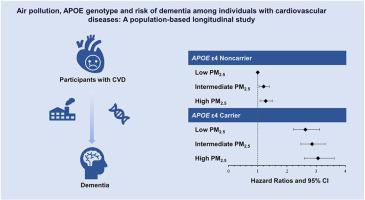当前位置:
X-MOL 学术
›
Environ. Pollut.
›
论文详情
Our official English website, www.x-mol.net, welcomes your feedback! (Note: you will need to create a separate account there.)
Air pollution, APOE genotype and risk of dementia among individuals with cardiovascular diseases: A population-based longitudinal study
Environmental Pollution ( IF 8.9 ) Pub Date : 2024-03-14 , DOI: 10.1016/j.envpol.2024.123758 Fei Tian , Zhengmin Qian , Zilong Zhang , Yuewei Liu , Gan Wu , Chongjian Wang , Stephen Edward McMillin , Elizabeth Bingheim , Hualiang Lin
Environmental Pollution ( IF 8.9 ) Pub Date : 2024-03-14 , DOI: 10.1016/j.envpol.2024.123758 Fei Tian , Zhengmin Qian , Zilong Zhang , Yuewei Liu , Gan Wu , Chongjian Wang , Stephen Edward McMillin , Elizabeth Bingheim , Hualiang Lin

|
Individuals with cardiovascular disease (CVD) are particularly vulnerable to dementia, but it remains unclear whether air pollution exposure links with higher risk of dementia among those with CVD. The data were derived from the UK Biobank study (UKB). Dementia-free participants with CVD at baseline were included. Air pollution exposure was assessed through land use regression models, including particulate matter (PM, PM, and PM), nitrogen dioxide (NO), and nitrogen oxides (NO). A Cox proportional hazards model was used to investigate the associations between air pollution exposure and incident dementia among individuals with CVD. Air pollution was associated with dementia among individuals with CVD, and the hazard ratios of dementia associated with each interquartile range (IQR) μg/m increase in air pollution were 1.07 (95% CI: 1.02, 1.12) for PM, 1.10 (95% CI: 1.04, 1.15) for PM, 1.08 (95% CI: 1.03, 1.14) for NO and 1.05 (95% CI: 1.00, 1.09) for NO. Associations between air pollution and all-cause dementia were found to be significant among individuals with hypertension. Adverse effects of air pollution were also observed for Alzheimer's dementia (AD) and vascular dementia (VaD), with a higher effect for AD. Observed associations remained similar in subgroups of ε4 carriers and noncarriers, although there was a higher risk difference across different air pollution concentration among these individuals carrying ε4. Air pollution emerges as a critical risk factor for dementia among individuals with CVD, regardless of genetic susceptibility indicated by the genotype. Notably, individuals with hypertension might be susceptible to the adverse effects of air pollution, leading to a higher incidence of dementia. Understanding these impacts on dementia among individuals with CVD may promote better targeted prevention and clinical management strategies.
中文翻译:

空气污染、APOE 基因型与心血管疾病患者痴呆风险:一项基于人群的纵向研究
患有心血管疾病 (CVD) 的人特别容易患痴呆症,但目前尚不清楚空气污染暴露是否与 CVD 患者患痴呆症的风险较高有关。数据来自英国生物银行研究(UKB)。基线时患有心血管疾病的无痴呆参与者也被纳入其中。通过土地利用回归模型评估空气污染暴露,包括颗粒物(PM、PM和PM)、二氧化氮(NO)和氮氧化物(NO)。 Cox 比例风险模型用于调查 CVD 患者空气污染暴露与痴呆事件之间的关联。空气污染与 CVD 患者中的痴呆症相关,空气污染每四分位数范围 (IQR) μg/m 增加相关的痴呆风险比为 1.07 (95% CI: 1.02, 1.12),PM 为 1.10 (95%) PM 的 CI:1.04、1.15)、NO 的 1.08(95% CI:1.03、1.14)和 NO 的 1.05(95% CI:1.00、1.09)。研究发现,空气污染与高血压患者之间的全因痴呆之间存在显着关联。还观察到空气污染对阿尔茨海默氏痴呆(AD)和血管性痴呆(VaD)有不利影响,其中对 AD 的影响更大。在 ε4 携带者和非携带者亚组中观察到的关联仍然相似,尽管这些携带 ε4 的个体在不同空气污染浓度下存在较高的风险差异。无论基因型表明的遗传易感性如何,空气污染已成为心血管疾病患者患痴呆症的一个关键危险因素。值得注意的是,高血压患者可能容易受到空气污染的不利影响,导致痴呆症的发病率更高。了解这些对心血管疾病患者痴呆症的影响可能会促进更好的有针对性的预防和临床管理策略。
更新日期:2024-03-14
中文翻译:

空气污染、APOE 基因型与心血管疾病患者痴呆风险:一项基于人群的纵向研究
患有心血管疾病 (CVD) 的人特别容易患痴呆症,但目前尚不清楚空气污染暴露是否与 CVD 患者患痴呆症的风险较高有关。数据来自英国生物银行研究(UKB)。基线时患有心血管疾病的无痴呆参与者也被纳入其中。通过土地利用回归模型评估空气污染暴露,包括颗粒物(PM、PM和PM)、二氧化氮(NO)和氮氧化物(NO)。 Cox 比例风险模型用于调查 CVD 患者空气污染暴露与痴呆事件之间的关联。空气污染与 CVD 患者中的痴呆症相关,空气污染每四分位数范围 (IQR) μg/m 增加相关的痴呆风险比为 1.07 (95% CI: 1.02, 1.12),PM 为 1.10 (95%) PM 的 CI:1.04、1.15)、NO 的 1.08(95% CI:1.03、1.14)和 NO 的 1.05(95% CI:1.00、1.09)。研究发现,空气污染与高血压患者之间的全因痴呆之间存在显着关联。还观察到空气污染对阿尔茨海默氏痴呆(AD)和血管性痴呆(VaD)有不利影响,其中对 AD 的影响更大。在 ε4 携带者和非携带者亚组中观察到的关联仍然相似,尽管这些携带 ε4 的个体在不同空气污染浓度下存在较高的风险差异。无论基因型表明的遗传易感性如何,空气污染已成为心血管疾病患者患痴呆症的一个关键危险因素。值得注意的是,高血压患者可能容易受到空气污染的不利影响,导致痴呆症的发病率更高。了解这些对心血管疾病患者痴呆症的影响可能会促进更好的有针对性的预防和临床管理策略。



























 京公网安备 11010802027423号
京公网安备 11010802027423号